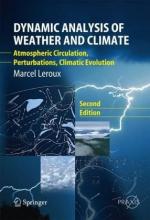|
This section contains 1,086 words (approx. 4 pages at 300 words per page) |

|
The troposphere, the lowest 9 mi (15 km) of Earth's atmosphere, is the layer in which nearly all weather activity takes place. Weather is the result of complex air circulation patterns that can best be described by going from the general to more localized phenomena.
The prime mover of air above Earth's surface is the unequal heating and cooling of Earth by the Sun. Air rises as it is heated and descends as it is cooled. The differences in air pressure cause air to circulate, which results in the creation of wind, precipitation, and other weather related features.
Earth's rotation also plays a role in air circulation. Centrifugal force, friction and the apparent Coriolis force are responsible for the circular nature of its flow, as well as for erratic eddies and surges.
On a global scale, there are three circulation belts between the equator and each pole. From...
|
This section contains 1,086 words (approx. 4 pages at 300 words per page) |

|


